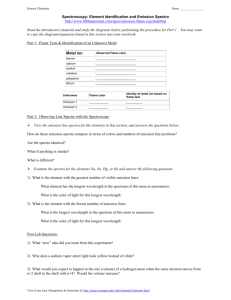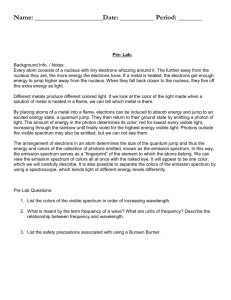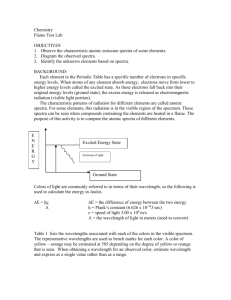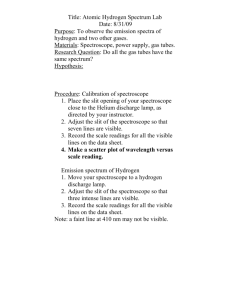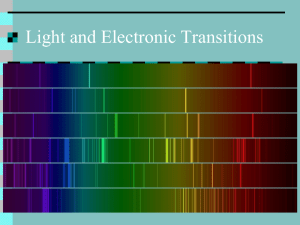Atomic Emission Spectrum Lab: Flame Tests & Spectroscopy
advertisement
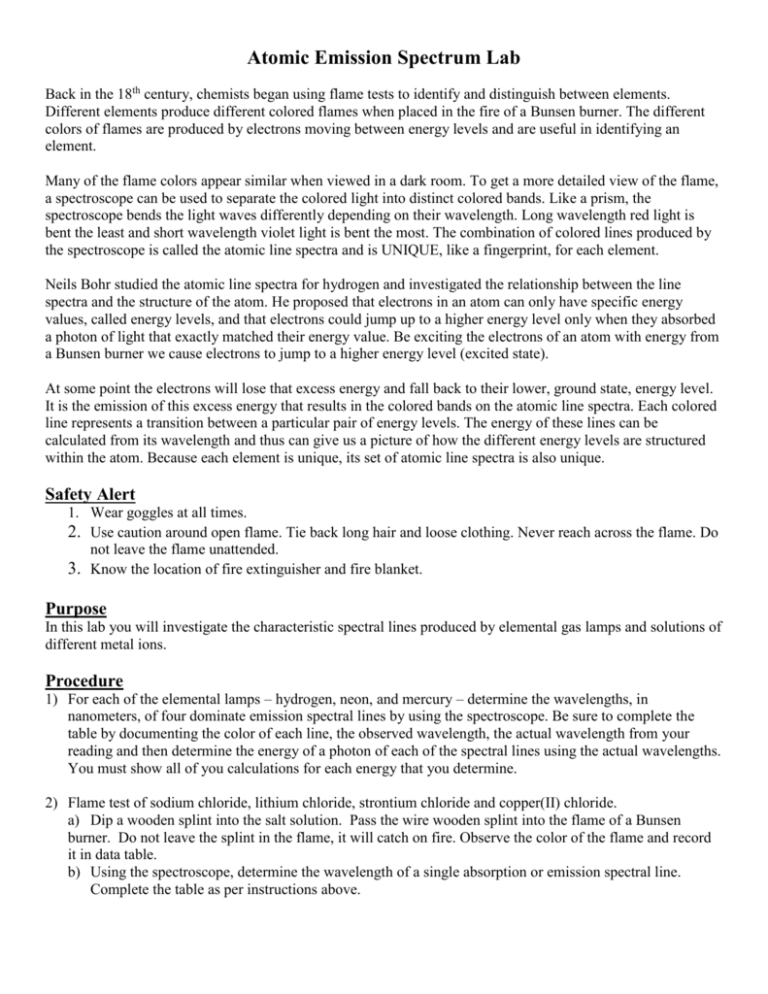
Atomic Emission Spectrum Lab Back in the 18th century, chemists began using flame tests to identify and distinguish between elements. Different elements produce different colored flames when placed in the fire of a Bunsen burner. The different colors of flames are produced by electrons moving between energy levels and are useful in identifying an element. Many of the flame colors appear similar when viewed in a dark room. To get a more detailed view of the flame, a spectroscope can be used to separate the colored light into distinct colored bands. Like a prism, the spectroscope bends the light waves differently depending on their wavelength. Long wavelength red light is bent the least and short wavelength violet light is bent the most. The combination of colored lines produced by the spectroscope is called the atomic line spectra and is UNIQUE, like a fingerprint, for each element. Neils Bohr studied the atomic line spectra for hydrogen and investigated the relationship between the line spectra and the structure of the atom. He proposed that electrons in an atom can only have specific energy values, called energy levels, and that electrons could jump up to a higher energy level only when they absorbed a photon of light that exactly matched their energy value. Be exciting the electrons of an atom with energy from a Bunsen burner we cause electrons to jump to a higher energy level (excited state). At some point the electrons will lose that excess energy and fall back to their lower, ground state, energy level. It is the emission of this excess energy that results in the colored bands on the atomic line spectra. Each colored line represents a transition between a particular pair of energy levels. The energy of these lines can be calculated from its wavelength and thus can give us a picture of how the different energy levels are structured within the atom. Because each element is unique, its set of atomic line spectra is also unique. Safety Alert 1. Wear goggles at all times. 2. Use caution around open flame. Tie back long hair and loose clothing. Never reach across the flame. Do not leave the flame unattended. 3. Know the location of fire extinguisher and fire blanket. Purpose In this lab you will investigate the characteristic spectral lines produced by elemental gas lamps and solutions of different metal ions. Procedure 1) For each of the elemental lamps – hydrogen, neon, and mercury – determine the wavelengths, in nanometers, of four dominate emission spectral lines by using the spectroscope. Be sure to complete the table by documenting the color of each line, the observed wavelength, the actual wavelength from your reading and then determine the energy of a photon of each of the spectral lines using the actual wavelengths. You must show all of you calculations for each energy that you determine. 2) Flame test of sodium chloride, lithium chloride, strontium chloride and copper(II) chloride. a) Dip a wooden splint into the salt solution. Pass the wire wooden splint into the flame of a Bunsen burner. Do not leave the splint in the flame, it will catch on fire. Observe the color of the flame and record it in data table. b) Using the spectroscope, determine the wavelength of a single absorption or emission spectral line. Complete the table as per instructions above. Data and Observations Data Table Source Observed Color Observed λ (nm) Actual λ (nm) Energy (J) Hydrogen Neon Mercury Sodium (Na1+) Lithium (Li1+) Strontium (Sr2+) Copper (Cu2+) Analysis: Calculations for Energy to be completed on a separate sheet of paper. Determine the percent error of energy of the red line in the hydrogen spectra with your observed wavelength and the actual wavelength from the reading. Show all work and calculations. Conclusion Questions. 1) List the colors of the visible spectrum in order of increasing energy. 2) If you have two flame colors that seem identical, how can you distinguish between them? 3) How can the existence of spectra help to prove the energy levels in atoms exist? 4) How can the single electron in a hydrogen atom produce all of the lines found in its emission spectrum?
